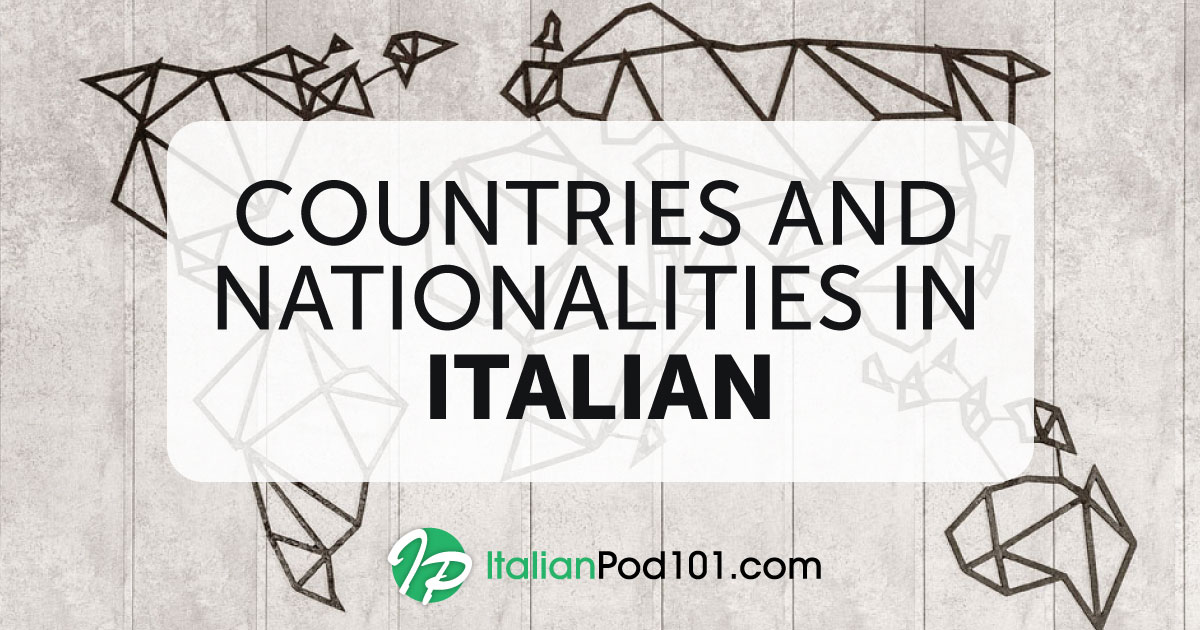
Are you traveling through Italy? Do you need to get to the Colosseum? Are you taking art classes in Florence?
If you’re in Italy and you want to enjoy getting around and exploring new places, get ready to ask for directions in Italian with this quick and easy guide. No need for maps or GPS if you can get a little help from locals and practice your Italian in the process.
In this article, I’ll be going over direction phrases in Italian, and will teach you words like “right” in Italian and much more!

Table of Contents
- On the Map: Cardinal Directions in Italian
- On the Road: Street Directions in Italian
- Directions in Italian Using Landmarks
- Italian Phrases for Asking (Politely) for Directions
- Must-know Italian Phrases for Giving Directions
- If You Get Lost
- Streets, Squares, and More (Much More!)
- Conclusion
1. On the Map: Cardinal Directions in Italian
Whether you’re old-school and like to rely on paper maps, or you’re more into new gadgets and like to get around with GPS apps, one of the first things to learn is how to ask for compass directions in Italian when planning your trip on a map.
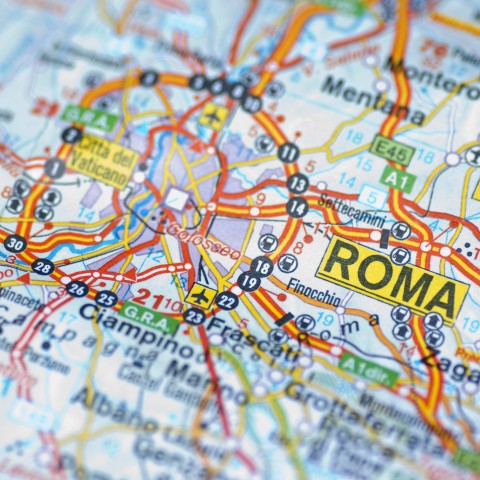 Tutte le strade portano a Roma. (“All roads lead to Rome.”)
Tutte le strade portano a Roma. (“All roads lead to Rome.”)
- Nord — “North”
- Sud — “South”
- Est — “East”
- Ovest — “West”
These (and their combinations nord-est, sud-ovest, etc.) are the essential words you need to learn to find your way around a map of the country. Other than that, Italians don’t have the habit of referring to cardinal points when giving directions, and they’re mainly used to indicating the parts and areas of Italy.
When talking about directions in English, it’s very common to say things like “go north on Second Street” (prosegui a nord su Second Street). Instead, Italians almost never use directions when giving directions. Italians mostly mention the directions when describing geographical features.
-
– Milano è nel nord d’Italia.
“Milan is in the north of Italy.”
– Napoli e Palermo sono le maggiori città del sud d’Italia.
“Naples and Palermo are the major cities in the south of Italy.”
– Pompei si trova a sud di Napoli.
“Pompeii is located south of Naples.”
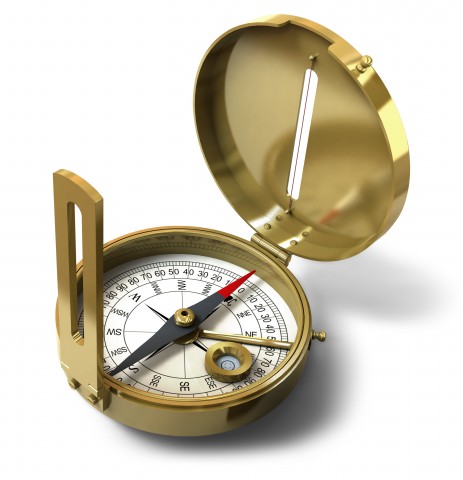 Hai perso la bussola? (Literally, “Did you lose your compass?” meaning also “Are you lost? Out of your mind?”)
Hai perso la bussola? (Literally, “Did you lose your compass?” meaning also “Are you lost? Out of your mind?”)
In Italy, you’ll never hear someone talking about the north part of the city. Instead, almost every city can be divided into il centro storico, or “the historical center,” historically the old part of town, and la periferia or “the outskirts”/”the suburbs,” which are the newer parts of the town.
2. On the Road: Street Directions in Italian

For road directions in Italian, you’ll need a series of relative indicators that will help you easily find where to go. Here are the most important ones:
| a destra; a sinistra | “to the right”; “to the left” |
| davanti; dietro | “in front”; “behind” |
| vicino; lontano | “near”; “far” |
| accanto a | “next to” |
| all’angolo; dietro l’angolo | “at the corner”; “around the corner” |
| da questo lato; dall’altro lato | “on this side”; “on the other side” |
| a [due minuti] di distanza | “it’s [two minutes] away” |
Notice to say “right” in Italian we say destra, but just in the sense of left and right. If you mean “right” as in “correct,” you’ll have to say giusto. Giusto?
-
A: È vicino il Duomo?
“Is the Duomo near?”
B: Saranno 5 minuti a piedi.
“It’s probably a five-minute walk.”
B: Prendi la prima a sinistra, poi la seconda a destra. Il Duomo è dietro l’angolo.
“You turn left at the first intersection, then turn right at the second intersection. The Duomo is around the corner.”
3. Directions in Italian Using Landmarks
When you’re traveling, there are so many landmarks that you’ll go to or pass by. So it’s important to know the names of the main public buildings and of all the places of tourist interest in a particular city. When asking for directions, make sure you know the following words and phrases:
Around the City
| l’aeroporto | “the airport” |
| la stazione (dei treni, degli autobus) | “the (train, bus) station” |
| l’accesso alla metro | “the access to the subway” |
| la fermata dell’autobus | “the bus stop” |
| il centro | “downtown” |
| il centro commerciale | “the shopping center” |
| il parco | “the park” |
| l’albergo; l’hotel; l’ostello | “the hotel”; “the hostel” |
| l’ospedale | “the hospital” |
| la banca; il bancomat | “the bank”; “the cash machine” |
| l’ufficio postale | “the post office” |
| il parcheggio dei taxi | “the taxi parking” |
| il museo; il teatro; il cinema | “the museum”; “the theater”; “the cinema” |
| la chiesa | “the church” |
| il ristorante; la trattoria; la pizzeria | “the restaurant”; “the tavern”; “the pizzeria” |
| il bar; la gelateria | “the coffee bar”; “the ice cream shop” |
| il supermercato; il mercato | “the supermarket”; “the market” |
| l’edicola | “the newsstand” |
| la farmacia | “the pharmacy” |
| la scuola | “the school” |
| il benzinaio; il distributore di benzina | “the gas station” |
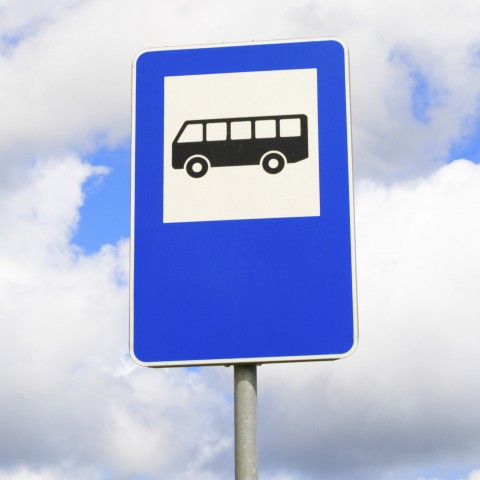 La fermata dell’autobus. (“The bus stop.”)
La fermata dell’autobus. (“The bus stop.”)
-
– La farmacia è di fronte all’ospedale.
“The pharmacy is in front of the hospital.”
– Per andare al supermercato, vai sempre dritto fino al benzinaio, gira a destra, poi continua fino al secondo semaforo e infine gira a sinistra.
“To go to the supermarket, go straight to the gas station, turn right, then continue to the second traffic light and then turn left.”
On the Street
| l’incrocio | “the intersection” |
| il semaforo (verde, rosso, giallo) [link to colors] | “the traffic light” (green, red, yellow) |
| le strisce pedonali (le strisce) | “the pedestrian crossing” |
| il marciapiede | “the sidewalk” |
-
– La fermata dell’autobus è a duecento metri dal semaforo.
“The bus stop is two-hundred meters from the traffic light.”
– Quando arrivi all’incrocio, attraversa sulle strisce pedonali e aspettami sul marciapiede.
“When you reach the intersection, cross on the pedestrian crossing and wait for me on the sidewalk.”
Inside a Building
| il bagno | “the toilet” (or bathroom) |
| l’ascensore | “the elevator” |
| le scale | “the stairs” |
| la porta; il portone; il cancello | “the door”; “the main door”; “the gate” |
| l’entrata; l’uscita | “the entry”; “the exit” |
| il parcheggio (la cassa per pagare il parcheggio) | “the parking” (the cash desk to pay the parking) |
-
– Dov’è il bagno?
“Where is the bathroom?”
– Per favore, potrebbe indicarmi l’uscita?
“Can you show me the exit, please?”
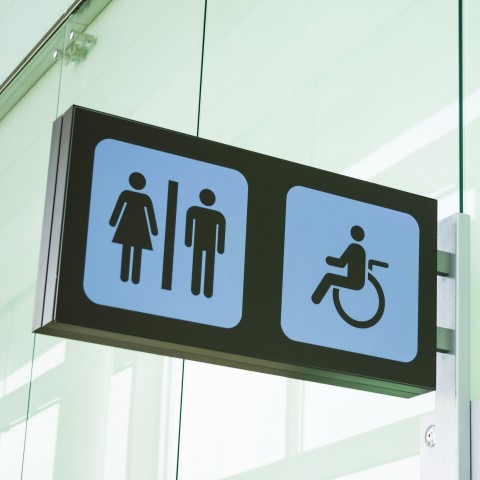 Scusi, dov’è il bagno? (“Excuse me, where is the bathroom?”)
Scusi, dov’è il bagno? (“Excuse me, where is the bathroom?”)
4. Italian Phrases for Asking (Politely) for Directions
If you want to make sure that you’re given the best directions to the place you want to go, you might want to master a few must-know phrases that will allow you to ask politely and make a great first impression on the person you’re asking. Italians are usually very happy to help a tourist, especially a foreign one, but courtesy always goes a long way.
Scusi…
The first and most important phrase when asking directions in Italian is Scusi (scusa for informal) which literally means “may you excuse,” but basically just serves to catch the attention of the other person. (If you need a quick refresher on when we use formal/informal in Italian, check out this video.) Whenever you ask for directions, make sure you always start with that.
-
– Ciao, scusa, dov’è la scuola?
“Hi, excuse me, where is the school?”
– Scusi, dove prendo l’autobus per il centro?
“Excuse me, where do I take the bus downtown?”
– Scusi, potrebbe darmi un’indicazione?
“Excuse me, could you give me an indication?”
Did you notice that often when we ask politely, we end up using the conditional tense? So now is a very good opportunity to check out uses and conjugations, don’t you agree?
Dov’è…?
When you want to know where a certain place is, you have a few different ways of saying it:
Dov’è / dove si trova / come si va (“where it is” / “where is located” / “how do you go”). They can all be used to ask directions to a specific place.
-
– Scusi, dov’è il supermercato più vicino?
“Excuse me, where is the closest market?”
– Scusi, dove si trova il bagno delle donne?
“Excuse me, where is the lady’s bathroom?”
– Come si va a Pompei?
“How do I go to Pompeii?”
Per favore
Kindness is never too much, especially when you’re asking a favor from a stranger, so you might want to add a few “please”s with your question. And how do you say “please” in Italian? Per favore, of course. And can you guess what favore literally means? A favor? Please…
-
– Scusi, potrebbe dirmi per favore come si arriva al Duomo?
“Excuse me, can you please tell me how to get to the Duomo?”

Quanto dista?
Not only do you need to get to your destination, but you also need to know how far/long it is to get there. You have many different ways to ask that:
- Quanto dista?
“How far is it?”
Literally: “How much it is distant?” - È lontano?
“Is it far?” - Quanto ci vuole?
“How long does it take?”
Literally: “How much [time] it’s necessary to get there?”
Grazie mille!
Once you have all the information you need, make sure you know how to properly thank the nice person who helped you get where you needed to. Grazie! (“Thanks!”) is obviously the basic appreciation, but if you want to get a bit fancier, you have a few more options:
- Grazie.
“Thank you.” - Grazie mille. or Mille grazie.
“Thank you very much.”
Literally: “Thank you a thousand.” - Grazie tante. or Tante grazie.
“Many thanks.” - Molto gentile.
“Very kind.” - La ringrazio. / Ti ringrazio. (formal / informal)
“Thank you.”
Literally: “I thank you.”
5. Must-know Italian Phrases for Giving Directions

Are you familiar enough with your whereabouts that you feel confident giving directions to other people? Well done! Here’s how to give directions in Italian with a few simple phrases. And always remember the basic rule: if you know the person you’re talking to, go ahead and use the tu (2nd person – informal); otherwise, stick to Lei (3rd person – formal).
On the Street
- vai — “go”
- continua/prosegui — “keep going”
- Dritto — “straight”
- torna indietro — “go back”
- fai un’inversione (a U) — “make a U-turn”
- gira / svolta — “turn”
- a destra / a sinistra — “to the right” / “to the left”
– Per il Colosseo, continua dritto.
“To the Colosseum, keep going straight.”
– La strada è interrotta, fai una inversione a U e torna indietro.
“The street is blocked, make a U-turn and go back.”
On the Stairs
- al ventesimo piano — “on the twentieth floor”
- primo, secondo, ecc., ultimo piano — “first, second, etc., last floor”
- prendere le scale — “take the stairs”
- prendere l’ascensore — “take the elevator”
- salire / scendere — “go up” / “go down”
- a che piano va(i)? — “What floor?”
– L’ufficio postale è al secondo piano.
“The post office is on the second floor.”
– Di solito prendo le scale, ma oggi vado all’ultimo piano e prenderò l’ascensore.
“I usually take the stairs, but today I will go to the top floor and will take the elevator.”
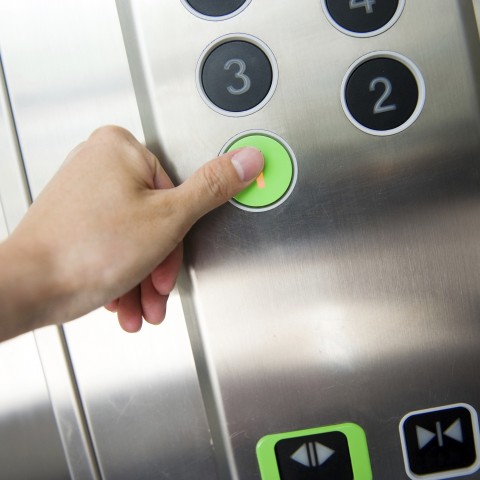 A che piano va? (“What floor?”)
A che piano va? (“What floor?”)
To a Driver
When giving suggestions to your driver, unless he/she is a friend of yours giving you a ride, you should address the driver using the formal Lei. Here are some useful taxi directions in Italian:
- continui — “go on”; “keep going”
- può fermarsi? — “Can you stop?”
- può andare più veloce? — “Can you go faster?”
- ho fretta, sono in ritardo — “I’m in a hurry, I am late.”
- può andare più piano? — “Can you go slower?”
- Non ho fretta, questa non è la formula 1… — “I’m not in a hurry, this is not the Formula 1…”
– Può fermarsi in Piazza San Marco?
“Could you stop in San Marco square?”
– Devo prendere il treno, può andare più veloce?
“I have to take the train, can you go faster?”
6. If You Get Lost
Even if you know all the vocabulary and all the must-know Italian phrases, even with maps and GPS and written-down directions, getting a little lost is common when you travel in a foreign country. So, get prepared for that possibility.
But don’t worry about it because, first of all, Italians are a generous and helping people and they’ll love to help you find your way back. And second, getting lost and just wandering around for a bit isn’t such a bad thing after all. Don’t you agree?
- Mi sono perso/a. — “I got lost.”
- Non trovo… — “I can’t find…”
- Non so come arrivare… — “I don’t know how to get to…”
- Mi potresti/potrebbe aiutare? — “Could you help me?”
– Dove vado? Non so come arrivare in centro…
“Where do I go? I don’t know how to get to the center…”
– Penso di essermi persa. Mi potrebbe aiutare ad arrivare in Via Roma?
“I think I got lost. Could you help me to get to Roma street?”
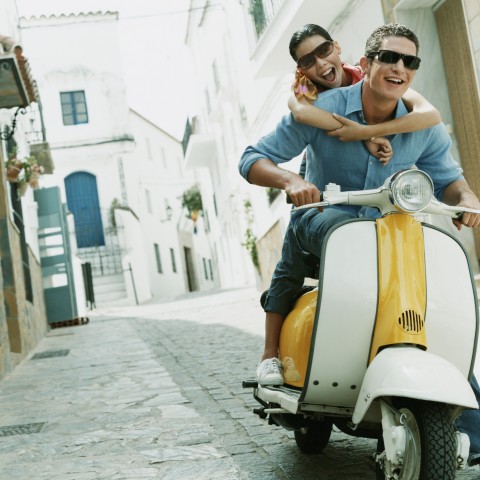 In Vespa per i vicoli di Roma. (“Riding a Vespa through Rome narrow streets.”)
In Vespa per i vicoli di Roma. (“Riding a Vespa through Rome narrow streets.”)
7. Streets, Squares, and More (Much More!)
Surely you won’t have any problem giving or understanding directions in English. But when people give you directions in Italy, they might use unfamiliar names to refer to places around the cities, especially the more historical ones. Here’s a useful list for you:
| Via | “Street” |
| Viale | “Avenue” |
| Vialetto | “Alley” (usually leading to a house) |
| Vicolo | Vicolo |
| Vicolo cieco | “Cul-de-sac” (also metaphorically) |
| Strada statale / strada provinciale | “State highway” / “provincial road” |
| Autostrada | “Highway” |
| Svincolo | “Junction”; “exit” (on a highway) |
| Casello (per il pedaggio) | “Toll gate” |
| Stazione di servizio | “Service station” |
| Piazza | “Square” |
| Rotonda, rotatoria | “Roundabout” |
In Italian, you can always use the diminutive form of a noun or an adjective to give it a slightly different meaning. And we do it all the time! So, don’t worry if you hear people telling you about vicoletti, stradine, cancelletti, portoncini, and porticine (“tiny alleys, narrow streets, mini-gates, and cute little doors”). If you still have some doubts, just check out how diminutive and other fun suffixes work.
Il centro di Napoli è pieno di vicoletti e stradine.
“Downtown Naples is full of tiny alleys and narrow streets.”
Cappuccetto Rosso vive in una casetta nel bosco.
“Little Red Riding Hood lives in a small house in the woods.”
8. Conclusion

Do you better understand directions in Italian now? Can you easily find your way around Florence, the Colosseum, Torre di Pisa, and the train to Pompei?
Good job! Now just keep going straight ahead (sempre dritto) to ItalianPod101.com for more fun and useful lessons to get you exactly where you need to be with your knowledge of Italian!
Happy learning!







